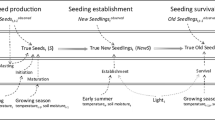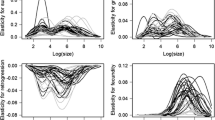Abstract
There is concern about the lack of recruitment of Acacia trees in the Negev desert of Israel. We have developed three models to estimate the frequency of recruitment necessary for long-term population survival (i.e. positive average population growth for 1,000 years and <10% probability of extinction). Two models assume purely episodic recruitment based on the general notion that recruitment in arid environments is highly episodic. They differ in that the deterministic model investigates average dynamics while the stochastic model does not. Studies indicating that recruitment episodes in arid environments have been overemphasized motivated the development of the third model. This semi-stochastic model simulates a mixture of continuous and episodic recruitment. Model analysis was done analytically for the deterministic model and via running model simulations for the stochastic and semi-stochastic models. The deterministic and stochastic models predict that, on average, 2.2 and 3.7 recruitment events per century, respectively, are necessary to sustain the population. According to the semi-stochastic model, 1.6 large recruitment events per century and an annual probability of 50% that a small recruitment event occurs are needed. A consequence of purely episodic recruitment is that all recruitment episodes produce extremely large numbers of recruits (i.e. at odds with field observations), an evaluation that holds even when considering that rare events must be large. Thus, the semi-stochastic model appears to be the most realistic model. Comparing the prediction of the semi-stochastic model to field observations in the Negev desert shows that the absence of observations of extremely large recruitment events is no reason for concern. However, the almost complete absence of small recruitment events is a serious reason for concern. The lack of recruitment may be due to decreased densities of large mammalian herbivores and might be further exacerbated by possible changes in climate, both in terms of average precipitation and the temporal distribution of rain.







Similar content being viewed by others
References
Adler FR (1998) Modeling the dynamics of life: calculus and probability for life scientists. Brooks/Cole, Pacific Grove
Alpert P, Ben-Gai T, Baharad A, et al. (2002) The paradoxical increase of Mediterranean extreme daily rainfall in spite of decrease in total values. Geophys Res Lett 29:1536
Ashkenazi S (1995) Acacia trees in the Negev and the Arava, Israel: a review following reported large-scale mortality (in Hebrew, with English summary). Hakeren Hakayemet LeIsrael, Jerusalem
BenDavid-Novak H, Schick AP (1997) The response of Acacia tree populations on small alluvial fans to change in the hydrological regime: Southern Negev, Israel. Catena 29:341–351
Ben-Gai T, Bitan A, Manes A, Alpert P, Rubin S (1998) Spatial and temporal changes in rainfall frequency distribution patterns in Israel. Theor Appl Climatol 61:177–190
Case TK (1999) An illustrated guide to theoretical ecology. Oxford University Press, Oxford
Chesson PL, Warner RR (1981) Environmental variability promotes coexistence in lottery competitive systems. Am Nat 117:923–943
Coe M, Coe C (1987) Large herbivores, Acacia trees and bruchid beetles. S Afr J Sci 83:624–635
Crisp MD (1978) Demography and survival under grazing of three Australian semi-desert shrubs. Oikos 30:520–528
Danin A (1983) Desert vegetation of Israel and Sinai. Cana Press, Jerusalem
Euler L (1760) Recherches generales sur la mortalite: la multiplication du genre humain. Mem Acad Sci Berl 16:144–164
Halevy G (1974) Effects of gazelles and seed beetles (Bruchidae) on germination and establishment of Acacia species. Isr J Bot 23:120–126
Halevy G, Orshan G (1972) Ecological studies on Acacia species in the Negev and Sinai. I. Distribution of Acacia raddiana, A. tortilis and A. gerrardii ssp. negevensis as related to environmental factors. Isr J Bot 21:197–208
Hanski I (1999) Metapopulation ecology. Oxford University Press, Oxford
Henle K, Sarre S, Wiegand K (2004) The role of density regulation in extinction processes and population viability analysis. Biodiv Conserv 13:9–52
Higgins SI, Bond WJ, Trollope SW (2000a) Fire, resprouting and variability: a recipe for grass-tree coexistence in savannna. J Ecol 88:213–229
Higgins SI, Pickett STA, Bond WJ (2000b) Predicting extinction risks for plants: environmental stochasticity can save declining populations. Trends Ecol Evol 15:516–520
Jeltsch F, Weber GE, Grimm V (2000) Ecological buffering mechanisms in savannas: a unifying theory of long-term tree-grass coexistence. Plant Ecol 150:161–171
Kiyiapi JL (1994) Structure and characteristics of Acacia tortilis woodland on the Njemps Flats. 27:47–69
Kutiel H (2001) Climatic uncertainty in the Mediterranean basin (in Hebrew). In: Kliot N (ed) Studies in natural resources and environmental management. Faculty of Humanities, Haifa University, pp 29–43
Lahav-Ginott S, Kadmon R, Gersani M (2001) Evaluating the viability of Acacia populations in the Negev desert: a remote sensing approach. Biol Conserv 98:127–137
Lamprey HF, Halevy G, Makacha S (1974) Interactions between Acacia, bruchid seed beetles and large herbivores. E Afr Wildl J 12:81–85
Levins R (1969) Some demographic and genetic consequences of environmental heterogeneity for biological control. Bull Entomol Soc Am 15:237–240
Lotka AJ (1907) Studies on the mode of growth of material aggregates. Am J Sci 24:199–216
Maley CC, Caswell H (1993) Implementing i-state configuration models for population dynamics: an object-oriented programming approach. Ecol Modell 68:75–89
Miller MF (1994) The costs and benefits of Acacia seed consumption by ungulates. Oikos 71:181–187
Milton SJ (1995) Spatial and temporal patterns in the emergence and survival of seedlings in arid Karoo shrubland. J Appl Ecol 32:145–156
Or K, Ward D (2003) Three-way interactions between Acacia, large mammalian herbivores and bruchid beetles—a review. Afr J Ecol 41:257–265
Otterman J, Manes A, Rubin S, Alpert P, Starr DO (1990) An increase of early rains in southern Israel following land-use change. Boundary-Layer Meteorol 53:333–351
Perlin N, Alpert P (2001) Effects of land-use modification on potential increase of convection: a numerical mesoscale study over south Israel. J Geophys Res Atmos 106:22621–22634
Rohner C, Ward D (1999) Large mammalian herbivores and the conservation of arid Acacia stands in the Middle East. Conserv Biol 13:1162–1171
Steinberger EH, Gazit-Yaari N (1996) Recent changes in the spatial distribution of annual precipitation in Israel. J Clim 9:3328–3336
Walker BH (1993) Rangeland ecology: understanding and managing change. Ambio 22:80–87
Ward D, Rohner C (1997) Anthropogenic causes of high mortality and low recruitment in three Acacia tree species in the Negev desert, Israel. Biodiv Conserv 6:877–893
Watson IW, Westoby M, Holm AM (1997a) Continuous and episodic components of demographic change in two Eremophila species from arid Western Australia. J Ecol 85:833–846
Watson IW, Westoby M, Holm AM (1997b) Demography of two shrub species from an arid grazed ecosystem in Western Australia 1983–1993. J Ecol 85:815–832
Wiegand K (1999) A model of the spatio-temporal population dynamics of Acacia raddiana. UFZ report no. 15/1999. UFZ Centre for Environmental Research, Leipzig-Halle, Leipzig
Wiegand K, Jeltsch F, Ward D (1999) Analysis of the population dynamics of Acacia trees in the Negev desert, Israel with a spatially explicit computer simulation model. Ecol Modell 117:203–224
Wiegand K, Jeltsch F, Ward D (2000a) Do spatial effects play a role in the spatial distribution of desert-dwelling Acacia raddiana? J Veg Sci 11:473–484
Wiegand K, Ward D, Thulke H-H, Jeltsch F (2000b) From snap-shot information to long-term population dynamics of Acacias by a simulation model. Plant Ecol 150:97–115
Wilson TB, Witkowski ETF (1998) Water requirements for germination and early seedling establishment in four African savanna woody plant species. J Arid Environ 38:541–550
Acknowledgements
We thank Gabi Schachtel for helpful discussions throughout this project and Susan Schwinning and an anonymous reviewer for comments on the manuscript. During part of this work, Kerstin Wiegand was supported by the BMBF within BIOLOG (01LC 0020, BIOPLEX).
Author information
Authors and Affiliations
Corresponding author
Appendix
Appendix
Assuming that trees grow 1.5 cm in trunk circumference per year (cf. Kiyiapi 1994) and using age T in units of 5 years, trees can be classified into non-reproducing seedlings (<15 cm, T /5 years=0, 1), subadults with low seed production(15 cm–45 cm, T /5 years=2, 3, 4, 5), and adults (≥45 m, T /5 years ≥6) with full seed production (Wiegand et al. 1999). The number of seeds produced by a tree (S) of trunk circumference (tc; cm) is:
(Wiegand et al. 1999) or, in terms of age T (5 years):
Thirty-five percent of the subadult and 84% of the adult trees reproduce in a given year. On average, the number of seeds produced is reduced by 84% (subadults) and 75% (adults) due to mistletoe infestation and unfavourable moisture status (Wiegand et al. 1999).
Given a germination event under optimal weather conditions, a certain seed has a chance of 1.8×10-6 to evolve into a 5-year-old seedling. This is because 96.5% of the seeds are infested by seed beetles, 93% of the seeds get lost, 50% land at a safe site, 15.6% of the seeds at safe sites germinate, and semi-annual seedling mortality is 60% within the first 2.5 years and 1.74% over the following 2 years (Wiegand et al. 1999).
Thus, the number of offspring (O) produced by a subadult tree for a potential recruitment event is:
and the number of offspring produced by adults is:
Plotting number of offspring versus age reveals a linear relationship, which is approximately: O ≈0.12 T /Δt.
Rights and permissions
About this article
Cite this article
Wiegand, K., Jeltsch, F. & Ward, D. Minimum recruitment frequency in plants with episodic recruitment. Oecologia 141, 363–372 (2004). https://doi.org/10.1007/s00442-003-1439-5
Received:
Published:
Issue Date:
DOI: https://doi.org/10.1007/s00442-003-1439-5




